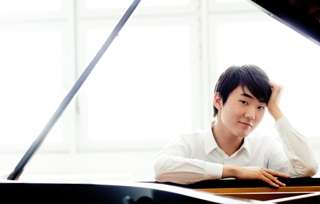|
Back
Spring in Paris Washington
The Kennedy Center
04/25/2019 - & April 26, 27, 2019
César Franck: Le Chasseur maudit
Maurice Ravel: Piano Concerto in G major
Camille Saint-Saëns: Symphony No. 3 in C minor, “Organ”, Op. 78
Seong-Jin Cho (piano), William Neil (organ)
The National Symphony Orchestra, Gianandrea Noseda (conductor)

S.-J. Cho (© Harald Hoffman)
Thursday’s French-themed NSO program began with a partial detour in César Franck’s The Accursed Huntsman; while based in Paris for most of his career, Franck was Belgian by birth. Perhaps even more than the Symphony in D minor, this tone poem—depicting a hunter condemned to be hunted perpetually himself by demons for neglecting Sunday Mass—plays to the composer’s dramatic strengths while affording minimal opportunity for the sort of maudlin sentimentality that, for me, tends to mar his chamber music. The work is thus a real thrill to hear, especially under a robustly committed performance such as what the NSO delivered under Gianandrea Noseda. The opening horn calls set the tone for the whole performance: carefully shaped yet urgently moving forward.
Next up was Ravel’s Piano Concerto in G major, composed around 1930, just after the composer’s introduction to Gershwin. I cannot claim much general affinity for French “impressionism” in music, yet I have always enjoyed this work’s evocative blend of jazzy effervescence with a touch of melancholy. Young soloist Seong-Jin Cho’s gently assertive, generally bright-toned playing was an asset here, and Noseda elicited some very lively and characterful playing in the work’s many woodwind solos.
Yet the feature presentation was the beloved “Organ” Symphony of Camille Saint-Saëns. I tend to find that the triumphant entrance of the organ halfway through the second and last movement feels less well-earned than similar but more effectively cathartic moments in works such as the Beethoven Fifth or the Schumann Fourth; yet even if this is not the most dramatically cohesive of late-Romantic symphonies (the work was completed in 1886), it is nonetheless a fine work with many charms that, on the whole, deserves its cherished place in the repertoire. Interpretively, a danger in this piece is that is that the long lead-up to that triumphant conclusion can come across as a little bland at times without a thoroughly committed performance; this applies especially to the Poco Adagio conclusion to the first movement, whose melodic material is lovely but rather understated.
Noseda’s excellent feel for dramatic contrast and the long-line paid off handsomely here. In the first movement, the climax of the development in the Allegro moderato section was especially thrilling; and under Noseda the orchestra effortlessly moves between thunderous fortissimos and alternating lyrical passages, with the latter always lovingly sculpted. The strings sounded a bit too dry for my liking at the start of the following Poco Adagio, yet they grew noticeably warmer by the end of the movement; and the majestic finale again seemed to bring out the best from all involved, in a fitting conclusion to a very satisfying evening.
Samuel Wigutow
|